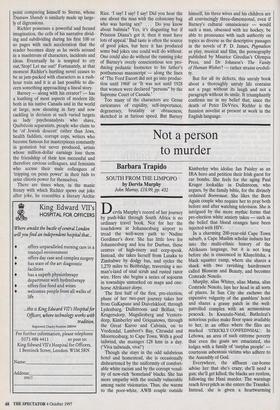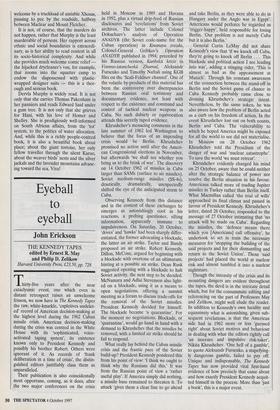Not a person to murder
Barbara Trapido
SOUTH FROM THE LIMPOPO ' by Dervla Murphy John Murray, £18.99, pp. 432 Dervla Murphy's record of her journey by push-bike through South Africa is no ordinary travel book. Not for her the touchdown at Johannesburg airport to tread the well-worn path to Nadine Gordimer's door. She has little love for Johannesburg and less for Durban, those centres of high-risery and corp-speak. Instead, she takes herself from Lusaka to Zimbabwe by dodgy bus, and cycles the 1,270 miles to Beitbridge, traversing a no- man's-land of sisal scrub and rusted razor wire. Here she begins a series of sojourns in townships unmarked on maps and one- horse Afrikaner cloips.
The first half of the first, pre-election, phase of her two-part journey takes her from GaKapane and Duivelskloof, through Lydenburg, Dullstroom and Belfast, to ICrugersdorp, Magaliesberg and Venters- dorp, Kimberley and Griquatown, through the Great Karoo and Calvinia, on to Vredendal, Lambert's Bay, Citrusdal and Moorreesburg, to Cape Town. With a good tailwind, she manages 128 kris in a day. ('Viva tailwinds, viva!') Though she stays in the odd salubrious hotel and homestead, she is occasionally disheartened by the uniformity of comfort- able white racism and by the corrupt venal- ity of new-rich 'homeland' blacks. She has more empathy with the socially vulnerable among racist visionaries. Thus, she warms to the poor-white, AWB couple outside Kimberley who idolise Ian Paisley as an IRA hero and petition their Irish guest for car bombs. She feels for the aging Paul Kruger lookalike in Dullstroom, who argues, by the family bible, for the divinely ordained Boerestaat. She likes the Born Again couple who require her to pray both before and after watching television. She is intrigued by the more mythic forms that pre-election white anxiety takes — such as the belief that blood oranges have been injected with HIV.
In a charming 200-year-old Cape Town suburb, a Cape Muslim scholar inducts her into the multi-ethnic history of the Afrikaans language, but it is not long before she is ensconced in Khayelitsha, a black squatter camp, where she shares a shack with two ravishing hairdressers called Blossom and Beauty, and becomes Comrade Noxolo.
Murphy, alias Whitey, alias Mama, alias Comrade Noxolo, lays her head in all sorts of places. In Sun City she eschews the expensive vulgarity of the gamblers' hotel and shares a grassy patch in the well- patrolled complex with an acrimonious peacock. In Kwazulu-Natal, Buthelezi's notorious police make floor space available to her, in an office where the files are marked `STRICKLY CONFEDNSIAL'. In Lebowa, an area of such extreme poverty that even the goats are emaciated, she lodges with a family of 'surplus people' — courteous asbestosis victims who adhere to the Assembly of God.
Everywhere, the affluent car-borne advise her that she's crazy; she'll need a gun; she'll get killed; the blacks are restless, following the Hani murder. The warnings reach fever pitch as she enters the Transkei. Instead, she is given a heartwarming welcome by a truckload of amiable Xhosas, pausing to pee by the roadside, halfway between Maclear and Mount Fletcher.
It is not, of course, that the murders do not happen, rather that Murphy is the least murderable of persons. Her rapport across ethnic and social boundaries is extraordi- nary, as is her ability to read context in all its socio-historical complexity. And while she provides much welcome comic relief — the hijacked drycleaner's van, for example, that zooms into the squatter camp to endow the dispossessed with plastic- wrapped designer suits — this is a thor- ough and serious book.
Deryla Murphy is widely read. It is not only that she carries Thomas Pakenham in her panniers and reads Edward Said under a gum tree. It is not only that she grieves for Hani, with his love of Homer and Shelley. She is prodigiously well-informed on South African affairs, from the 'tot' system, to the politics of water allocation. And, while this is a richly people-centred book, it is also a beautiful book about place; about the giant tortoise, her only fellow traveller through the silent Karoo, about the weaver birds' nests and the silver jackals and the lavender mountains advanc- ing toward the sea. Viva!











































































 Previous page
Previous page